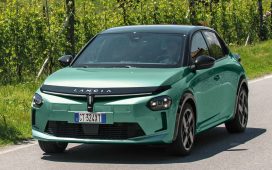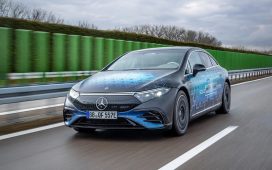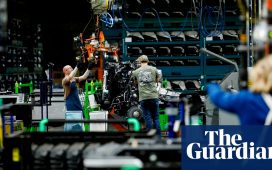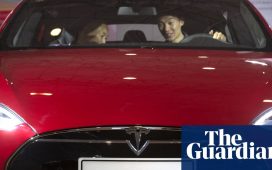There is an increasing media backlash against EVs, although UK sales are still growing (just not as fast). However, a lot more EV sales than most people realize are to fleet managers – and there’s still plenty of room to grow. The problem is that fleet managers are just as worried about the charging infrastructure as everyone else, and this is making them think twice about switching to electric. One new South Korea entrant into the UK charger market sees this as a ripe opportunity.
Private charging hubs could help fleet managers switch to EVs
Of the 315,000 EVs sold in the UK in 2023, 242,235 were attributed to the fleet sector. This is because the savings from choosing an EV salary sacrifice scheme and Benefit-in-Kind tax rates can be huge. But while the high initial cost of an EV can be reduced with these methods, that still leaves the concerns regarding reliable charging. On the one hand, motorway charging infrastructure is failing to meet targets in the UK. But according to Zapmap, the installation of ultra-rapid chargers and hubs has seen record growth. There is also a UK government scheme to ramp up rapid EV charging infrastructure with a £70 million ($89 million) injection of cash. But businesses want reliable infrastructure right now to be confident of the EV switch.
Could EV Charging Hubs Be The Answer?
“When we’re talking to fleet managers and leasing companies, the big barrier to entry for a lot of their clients is that they still don’t have the confidence that public infrastructure is going to be as easy as an ICE vehicle for refueling,” says James Sandison, Humax EV. This is why LEVC’s electric TX taxi a range extender rather than a full BEV. One of the options to combat this that Humax EV is working on is “transport hubs”, which would be like a car club. “This would be a semi-private gated area to give transport and fleet management companies a bit of confidence.”
“We’re also talking to leading energy companies about how they can help support this,” says Sandison. “This would ensure the rates are competitive. We’re trying to build a service rather than just being a charge point manufacturer and selling the hardware.” The idea of specialist fleet refueling is not such a leap. After all, commercial vehicles, particularly trucks, have their own refueling stations that could serve as a model for what Humax is planning.
Trucks have had their own special refueling stops for decades.
“We’re considering what those premises would need to look like,” says Sandison. “Ultimately, we want something that would be off a major highway, not open to the public, but open to a certain number of people. It wouldn’t be a customer’s own premises. It would be something we have developed. We have looked at some brown sites for this. It would be gated access, whether that’s authorization through an app, an RFID card, or a PIN code that was shared to you once you signed up. We’ve got all the ANPR number plate recognition technology out in South Korea, too.”
From Set-Top Boxes To EV Charging Car Parks
In the UK, if you’ve heard of Humax it will most likely be through its set-top boxes and PVRs for digital terrestrial and satellite television. The company also makes video streaming devices and has been building software for automotive infotainment. Its carmaker customers include General Motors, Renault, and Nissan, plus emerging brands in India and China. But in South Korea, Humax has built a significant profile in electric mobility. This model won’t translate directly to the UK, however – hence the focus on working with fleets.
“The business model in South Korea is different,” says Sandison. “We’ve grown through acquisition predominantly. We are the largest car park operator in South Korea, and we did that by acquiring the two largest car park companies. We’re in the top six of charge point operators and growing. We own the car park and through that we have the charging operation, we have maintenance, we have car wash as well.” Humax’s model is to offer all these services in addition to parking. The facilities are also used by car sharing services. This is all delivered through keyless entry using Humax’s app.
Humax’s skill in software is one of its primary USPs for its plans in the UK. While the company is most famous internationally for set top boxes, it’s the software inside them that is the most unique. Humax also delivers this for media companies, as well as automotive. “Charging hardware pretty much all does the same thing,” says Sandison. “The key for us was developing our own app. It’s not a white labeled app, it is a Humax development.”
Humax wants to be much more than just a supplier of EV charging hardware.
Humax’s app is intended to offer features like integration with solar power and domestic batteries and this is one of the reasons why Humax is only now starting to enter the UK market. “We wanted to launch it with solar features and everything else because we don’t have brand recognition yet within the recharging space,” says Sandison. “The idea is that we can keep adding to that app, such as the keyless entry for the cars.”
Fleet Charging And Beyond
The software will be central to Humax’s fleet rollout and imminent plans to provide an offering for domestic users. “We don’t want people bouncing in and out of different apps, having all these features and connected devices but having to switch between one app and another to control them,” says Sandison. “We are trying to make sure that that the Humax app will do everything for the wider connected ecosystem, including home energy management. When we go to the corporate clients, if you want the keyless entry on your vehicles as well, if you want the use-based insurance, it can all be done through the app.” Another feature would be license checking against the registered owner of a vehicle.
“We’ve developed this all in-house,” says Sandison. “Without making the app too bloated for people that aren’t using all the features, we want to control everything in one interface. We will have a very comprehensive offering.” An initial step for Humax will be launching 7kW AC home chargers, which is imminent for 2024, alongside some business premises. “We are working with a few property management companies to install commercial 7kW and 22kW chargers as well.” Humax is also hoping to work with automotive OEMs to be the preferred charger bundled with a new car purchase.
But the company sees fleet as the unique market where its offering has the greatest potential. “We’ve spoken with quite a few lease hire fleet management companies, and they’ve all got aggressive targets for fleet conversion to electric,” says Sandison. But to achieve these figures, they need to surmount the logistical problem of charging an EV fleet. “They will be more inclined to hit those conversion targets with a hub where 20 vehicles can charge, which is not open to the public, is gated, is secure, there are facilities, and it has a deal with an energy provider so they’re not paying extortionate public charging rates. It might even become a car park for them, so the fleet driver turns up in their own vehicle, switches vehicles for the fully charged electric vehicle, drives off for a day’s work, comes back and then goes home in their own vehicle again. It’s a big opportunity for us.”











